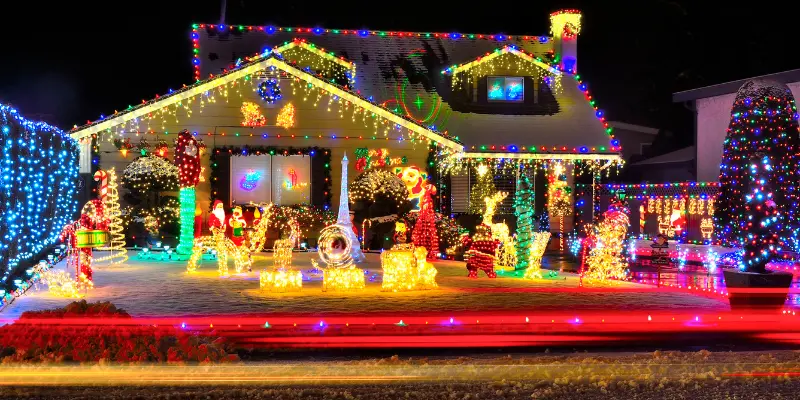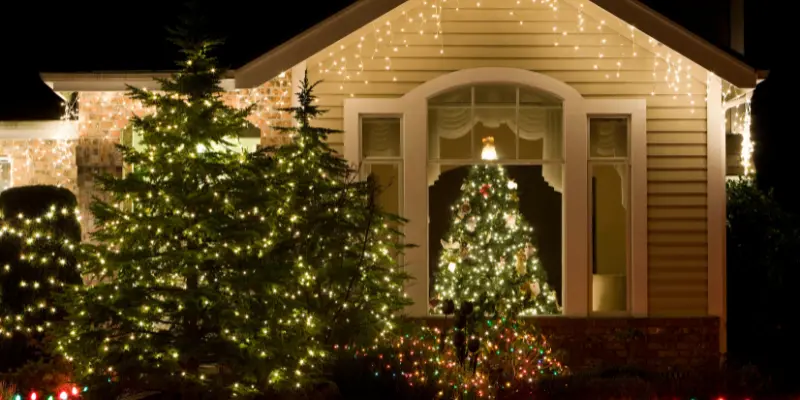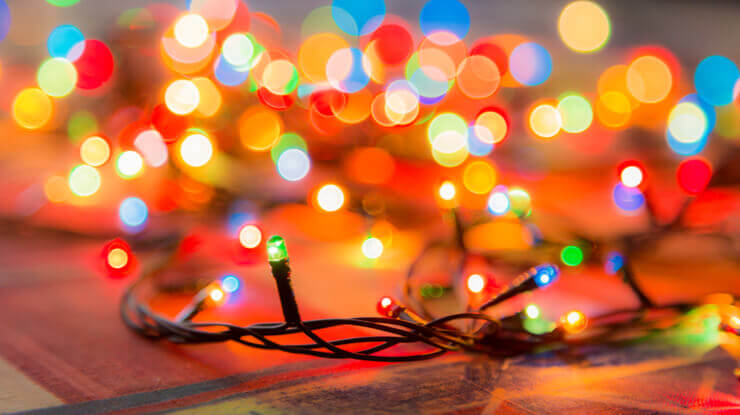Whether you prefer delicate light strands or imitate Clark Griswold in Christmas Vacation, holiday lights are a part of our traditions.
For most people, once they start, the light displays continue to grow, year after year. After all, who can pass up the deep discounts at those after-Christmas sales? But your electric bill will continue to grow too, unless you buy energy efficient LED holiday lights.
Bottom line? It’s time to toss out your old strings of lights. Today’s LED Christmas lights will add 90% less to your electric bill vs. traditional lights. If you’re looking to save (or accurately assess the full wattage of your Christmas decorations), our tools below will help you calculate what you generate each year and understand how your electric bill reflects these costs.
Incandescent vs. LED Christmas Lights – What’s the Difference?
Comparing regular Christmas lights vs. LED? While LEDs were initially known for their harsh glow, the newest models have little difference in appearance vs. incandescents.
The three key differences between incandescent and LED Christmas Lights are: (1) energy efficiency, (2) heat and (3) longevity. It’s all a factor of how the bulbs generate light.
Regular Christmas light string bulbs have a metal filament inside. Electricity heats the filament to produce light, but that also makes the bulbs too hot to handle. The filament is fragile, which makes them burn out quickly.
LED Christmas lights use a light-emitting diode (i.e., an LED) to generate light. That means less power usage, no heat and long life.
LEDs consume 80 to 90 percent less power than compared to incandescent lights, plus they last up to 100,000 hours (around 10 years!).
Electricity Cost Comparison of LED vs. Regular Christmas Lights
And the chart below shows how much less you will spend on your Christmas lights when you use LED bulbs vs. traditional. The savings are substantial!
Power Usage for Christmas Lights
| Item | Incandescent Watts | LED Watts |
|---|---|---|
| 400 ft C9 String on Roof | 2800 Watts | 385 Watts |
| 200 ft C9 String in Yard | 1400 Watts | 192 Watts |
| 10 Mini LED Strings for front yard trees | 403 Watts | 47 Watts |
| 15 Mini LED Strings for Christmas Tree | 612 Watts | 72 Watts |
| 1 Wreath with mini lights | 63 Watts | 7 Watts |
| Total Watts | 5278 Watts | 702 Watts |
| Total Kilowatts | 5.278 kilowatts | .702 kilowatts |
| Number of Hours Daily | 6 hours | 6 hours |
| Number of kWh Daily | 31.67 kWh Daily | 4.21 kWh Daily |
| Days Thanksgiving to January 5th | 41 days | 41 days |
| Total kWh for holiday lighting | 1,298.5 kWh used | 172.69 kWh used |
| Cost (at 16¢/kWh) | $207.76 | $27.63 |
How Much Will Christmas Lights Add to My Electric Bill?
To calculate how much you will spend on electricity for Christmas lights, follow this step by step process, or use the calculator tool below.
Time needed: 15 minutes
How to Calculate Total Electricity Cost for Christmas Lights
- Identify the type of Christmas lights and light types you will need.
Measure your areas to determine how many light strings you will need for your home. Include any lights you want on the roofline, shrubs, trees, plus interior lights.
- Identify the total wattage of your Christmas lights.
Use the internet or visit your local hardware store to find the wattage label on the lights you want. You’ll find this on the outside of the box, in the specifications section of the online listing, or on a label similar to the one below.

- Convert total watts to kilowatts
Divide total watts by 1000 to convert to kilowatts
- Estimate total daily usage of your lights and number of days you will have them lit.
For example, if you have your lights on from dusk until bedtime, you may have your lights on for 6 hours a day. Many people put up their Christmas lights the day after Thanksgiving and leave them up through the 12th day of Christmas, which is January 5th.
- Calculate the number of kilowatt hours you will use
Number of kilowatts * # hours per day * # of days = total amount of kilowatt hours you will use.
- Multiply total kilowatt hours by your average price per kilowatt hour (kWh)
For the calculator example below, we used a 66 foot long string of C9 (large size) bulbs that’s 215 watts, and assumed our home was lit up for 6 hours per day.
Over the course of a month, this light string would only use 38.7kWh. And it would add just $6.15 on your energy bill, based on the US average electricity rate of 15.91¢ per kWh.
Use the calculator tool below to calculate what your holiday light display will add to your electric bill.
How much electricity does a typical 215 watt 66Ft Outdoor Christmas Lights,100 LED C9 String Lights use?
| Usage | |
|---|---|
| Daily Usage | 1.3 kWh |
| Monthly Usage | 38.7 kWh |
| Annual Usage | 464.4 kWh |
Daily usage calculation is (watts * daily hours) / 1000.
Calculate electricity usage for your appliances.
| Wattage | |
| Hours Used Daily | |
| Energy Rate (¢/kWh) |
Your energy usage and cost for this appliance is :
| Usage | Cost | |
|---|---|---|
| Daily Usage | ||
| Monthly Usage | ||
| Annual Usage |
How Much Can I Save By Switching To LED Christmas Lights?
Switching your traditional Christmas lights out with newer LED Christmas lights can save you a surprising amount of money.
- If you have a typical modest Christmas display on your home, your energy costs would be approximately $10-$15 for incandescent lights, or around $2 for LEDs for the holiday season.
- For heavy usage where people slow down to see your house, the typical energy costs would be approximately $115 for traditional lights versus $15-$20 for LED lights.
- For a jaw-dropping display where people actually make your house a destination to admire your holiday cheer, the costs could be well over $300 with traditional lighting versus a modest $40-$50 with LEDs.

Benefits of LED Christmas Lights
It’s clear that LED holiday lights are the front runner in the competition for economical Christmas decorations, but that’s not the only benefit they have.
Here are some other benefits of LED Christmas lights:
- More lights. With traditional lights, you can only connect four or five strings of lights together on one outlet, limiting the amount of lights you can safely use in one area. With LED lights you can safely connect 20 plus light strings together. If the ultimate decorations are your holiday dream, LED lights are definitely the safer solution.
- More colors. LED Christmas lights come in a wider range of colors, are generally brighter than incandescent light strings, and even come in strings connected to dimmers for different lighting effects. Look for warm white to recreate the look of incandescent bulbs.
- More safety. LED Christmas lights don’t produce any heat, unlike incandescent bulbs. This means they’re safe for use within reach of children and pets, and pose almost no fire danger in case you have dry trees or grass in your landscape.
- Long lasting. LED light sets are generally rated to last decades, not just a season or two, meaning you can keep adding to your holiday collection each year instead of merely replacing burned out old versions of the same lights year after year.
Want to save even more on your electricity bill this holiday season? If you’re in a deregulated energy market, check your bill vs. current electricity rates to make sure you have a good rate. Use our guide to shopping for cheap power for more information.
Are Christmas Lights Expensive to Run?
Expensive typically comes down to budget. With Christmas lights, too, size and bulb type further influence how much you’ll spend illuminating your display every month of the holiday season.
We’ve covered total costs and compared traditional incandescent lights to LEDs. For a few more considerations:
- Mini Christmas lights, the narrow bulbs designed for indoor and outdoor use and often available in longer strings (up to 100 lights each), tend to cut down wattage and cost by virtue of their size. With incandescent bulbs, these Christmas lights use 0.95 kWh per day, even when turned on for six or more hours. With your electric bill, one strand adds about $4 per month. This isn’t bad for a single window or lights to accent your decorations, but the price spikes as soon as you start dressing a tree or your roof. LEDs slash electricity costs by nearly 90%: You might not even spend $0.50 per month for a single strand.
- C7 bulbs, also called ceramic bulbs, add those bright, joyous colors, but they come in shorter lengths with fewer lights (about 25 per strand). With incandescent bulbs, they’ll use about 3.15 kWh per day, costing you nearly $13 per month — which could be on par with electricity consumed by any appliance in your home.
- Inflation additionally means that you’re paying more to decorate your home. A study found that from 2021 to 2022, electricity costs jumped about 13%, even when daily habits remained unchanged. 2024 is expected to follow this pattern.

Christmas Lights and Electrical Safety
According to the National Fire Protection Fire Association, nearly half of home Christmas tree fires were caused by faulty electrical distribution (plugs) or lighting equipment.
Here are tips to maintain safety in your home:
For indoor decorations, make sure any extension cords are rated for the number of lights you are plugging in and the distance the cord is running. Occasionally check the extension cord at the electrical outlet. If the outlet or the extension cord are warm? That’s a problem. Unplug it and talk to an electrician.
For outdoor decorations, use an extension cord that’s rated for outdoor use and based on how far the power needs to travel. If you need a longer cord, purchase one with a heavy 12 or 10-gauge weight. For strings of lights, use 16-gauge extension cord for light runs of 25 feet or less and go with a heavier duty 14-gauge cord for runs over 25 feet.
When attaching lights to your home, consider using insulated hooks that you can install and leave up year round. That makes holiday decorating easy. If you are using a stapler for light installation, use U-shaped staples, specially created to avoid puncturing the electrical line.
Lastly, always turn your indoor and outdoor lights off at night. That helps ensure your safety. Plus it keeps your holiday light bill lower.

